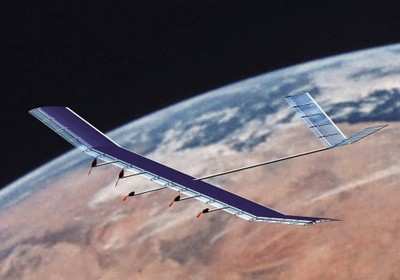Mon, Sep 10, 2007
But Record May Not Stick Without FAI Approval
QinetiQ tells ANN its Zephyr High Altitude Long Endurance (HALE)
Unmanned Aerial Vehicle (UAV) recently exceeded the official world
record time for the longest duration unmanned flight, with a 54
hour flight achieved during trials at the US Military's White Sands
Missile Range in New Mexico. The flight trials were funded through
the United Kingdom's Ministry of Defense (MOD) research
program.

The duration of the flight exceeded the current official FAI
world record for unmanned flight which stands at 30 hours 24
minutes set by Northrop Grumman's RQ-4A Global Hawk on March 22,
2001. As there was no FAI official present at White Sands, however,
it may not stand as an official world record.
Launched by hand, Zephyr is an ultra-lightweight carbon-fiber
aircraft with a wingspan of up to 18 meters, but weighing just 30
kg. By day it flies on solar power generated by amorphous silicon
arrays no thicker than sheets of paper that cover the aircraft's
wings. By night it is powered by rechargeable lithium-sulphur
batteries that are recharged during the day using solar power.
QinteiQ says the trials validated recent modifications that have
improved the efficiency of Zephyr's power system. These have
included new solar arrays supplied by United Solar Ovonic, a full
flight-set of Sion Power batteries as well as a novel solar-charger
and bespoke autopilot developed by QinetiQ, all of which were being
flown for the first time. During the trials the same aircraft was
flown twice while carrying a surveillance payload - first for 54
hours to a maximum altitude of 58,355 feet, and then for 33 hours
43 minutes to a maximum altitude of 52,247 feet.
"The possibilities suggested by unmanned flight are truly
exciting and with these trials Zephyr has secured its place in the
history of UAV development," said Paul Davey, Zephyr business
development director at QinetiQ. "Both flights were achieved in the
face of thunderstorms and debilitating heat in the hostile
environment of the New Mexico high desert in the summertime. They
have proved that an autonomous UAV can be operated on
solar-electric power for the duration required to support
persistent military operations."
More News
Aero Linx: Model Aeronautical Association of Australia MAAA clubs are about fun flying, camaraderie and community. For over 75 years, the MAAA has been Australia’s largest fl>[...]
Touchdown Zone Lighting Two rows of transverse light bars located symmetrically about the runway centerline normally at 100 foot intervals. The basic system extends 3,000 feet alon>[...]
“Discovery and innovation are central to our mission at Virgin Galactic. We’re excited to build on our successful record of facilitating scientific experiments in subor>[...]
How To Get A Story On Aero-TV News/Feature Programming How do I submit a story idea or lead to Aero-TV? If you would like to submit a story idea or lead, please contact Jim Campbel>[...]
Student Pilot Reported That During Rotation, “All Of A Sudden The Back Of The Plane Kicked To The Right..." Analysis: The student pilot reported that during rotation, “>[...]
 ANN's Daily Aero-Linx (05.02.24)
ANN's Daily Aero-Linx (05.02.24) ANN's Daily Aero-Term (05.02.24): Touchdown Zone Lighting
ANN's Daily Aero-Term (05.02.24): Touchdown Zone Lighting Aero-News: Quote of the Day (05.02.24)
Aero-News: Quote of the Day (05.02.24) ANN FAQ: Contributing To Aero-TV
ANN FAQ: Contributing To Aero-TV NTSB Final Report: Cirrus Design Corp SR20
NTSB Final Report: Cirrus Design Corp SR20



